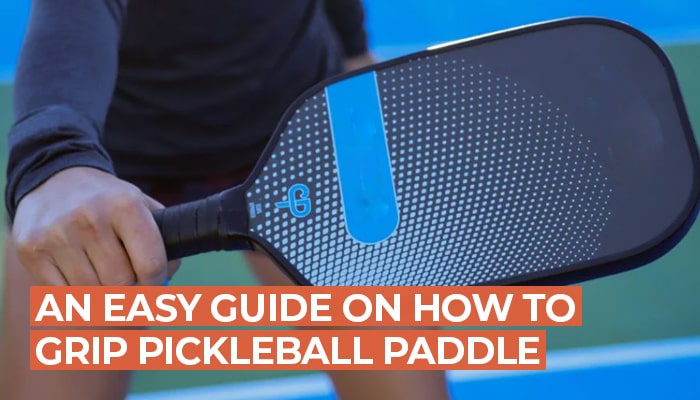Pickleball is a fast-paced game with different shots and strategies. The paddle grip is an important aspect of pickleball. If you want to improve your game, you need to know how to hold the paddle correctly. It is a very important part of the sport, so it is worth spending some time learning about it.
To be able to use your paddle effectively, you need to understand how to hold it properly. There are several different ways that people can hold their paddles. Each player has their own preferences when it comes to how they hold the paddle in their hands and how they want to execute different shots.
Many things can affect your shot execution such as your stance, how much pressure you apply on the paddle, or whether there is enough space between your body and the ball or not. These all play an important role in determining whether or not you would be able to hit your shot successfully. But the most important metier in pickleball is to hold the paddle properly. If you have a good grip on the paddle, you can easily execute different shots. But if you have a bad grip, then it will be very difficult for you to execute any shot.
How do hold Pickleball Paddle?
The first step to executing a shot is to grip your paddle. The second step is to swing it. The third step is to hit the ball. Holding your paddle correctly will help you hit more shots and improve your game. Here are some tips on how to hold a pickleball paddle:
Preferably, when you are learning about holding a paddle, you should find out what everyone else does. You must know what is considered best practice for holding a pickleball paddle. It is believed that a player should hold the paddle as close to his body as possible and with his arms relaxed. You must also make sure that your wrists are relaxed. A player should also keep his wrist straight and not bent in any direction. Your arms should also be extended and not bent at the elbows.
Holding the paddle in an upright position will give you a larger target area, which allows you to hit more shots with less effort. Also, holding it down gives you more control over how many spins you want on your ball when hitting a spike or overhead shot.

The next step would be to learn how much pressure each hand needs to get the best results when playing pickleball. Further, keep in mind that there are many types of shots in pickleball: forehand, backhand, and middle. Each shot requires a different grip on the paddle.
For example, forehand shots call for a more open palm while backhand shots call for a more closed palm (to hit harder).
Paddle Grip For Forehand Shots
The first type of shot is your forehand, which requires an open hand grip on your paddle with the thumb pointed toward the ground. This gives a V shape between fingers and thumb. This is the most common shot in pickleball because it’s easy to learn and execute. Forehands are used for pushing or driving on the front wall of your opponent’s court.
Paddle Grip For Backhand Shots
The second type of shot is your backhand, which also requires an open hand grip on your paddle but this time with the thumb pointed toward you. For backhand shots fingers are also not crossed on the paddle grip at 45 degrees. Instead, they are more straight like making a fist.
Backhands are used for going deep into the court for a kill shot or retrieving a ball that has been hit out of bounds.
Paddle Grip For Middle Attack
The third type of shot is called an inside forehand or middle attack, which requires an open hand grip on your paddle but this time with the thumb pointing toward your stomach area. Inside forehands can be used to go deep into the court or attempt to attack.
Types of Paddle Grip
There are many different ways to hold your paddle and each one of them has its benefits and drawbacks.
Straight Grip:
The most common way to hold a paddle is with the index finger and thumb on the handle, while the rest of your fingers wrap around it. This grip is known as “straight”, because it provides good balance and control, but can be difficult to use with some pickleball paddles.
Reverse Grip:
Another option is to grip the handle with your thumb on top and your fingers on the sides. This grip is called “reverse” because it gives you more control over the ball when throwing shots into the net, but it’s also harder to use because you have more hand movements than with “straight” grips.
Hammer Grip:
Also, known as continental pickleball grip is made with your knuckles spread across the paddle and making an angle of 45 degrees. This simply resembles your hand grip while hammering something.
There are other grips that you can use too, but these two are by far the most common ones used by beginners.
Conclusion:
Holding the paddle in the right manner is crucial while playing at a professional level. If someone wants to improve their game and is ready to learn how to do so. He must learn all the grip types and which type is suitable to execute certain shots.
